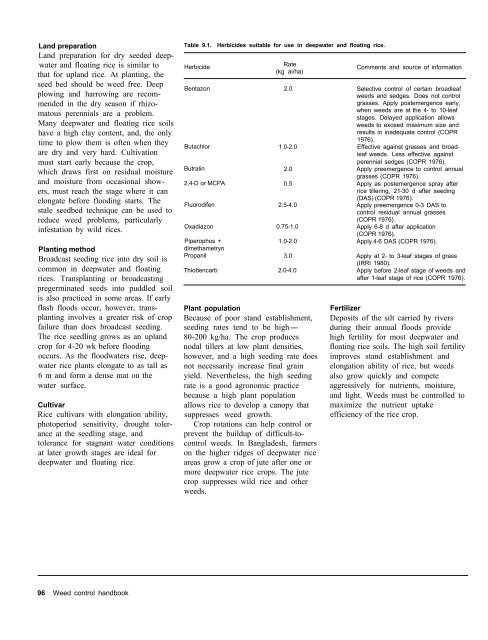A handbbok on Weed Control in Rice.pdf
A handbbok on Weed Control in Rice.pdf
A handbbok on Weed Control in Rice.pdf
Create successful ePaper yourself
Turn your PDF publications into a flip-book with our unique Google optimized e-Paper software.
Land preparati<strong>on</strong><br />
Land preparati<strong>on</strong> for dry seeded deep-<br />
water and float<strong>in</strong>g rice is similar to<br />
that for upland rice. At plant<strong>in</strong>g, the<br />
seed bed should be weed free. Deep<br />
plow<strong>in</strong>g and harrow<strong>in</strong>g are recom-<br />
mended <strong>in</strong> the dry seas<strong>on</strong> if rhizo-<br />
matous perennials are a problem.<br />
Many deepwater and float<strong>in</strong>g rice soils<br />
have a high clay c<strong>on</strong>tent, and, the <strong>on</strong>ly<br />
time to plow them is often when they<br />
are dry and very hard. Cultivati<strong>on</strong><br />
must start early because the crop,<br />
which draws first <strong>on</strong> residual moisture<br />
and moisture from occasi<strong>on</strong>al show-<br />
ers, must reach the stage where it can<br />
el<strong>on</strong>gate before flood<strong>in</strong>g starts. The<br />
stale seedbed technique can be used to<br />
reduce weed problems, particularly<br />
<strong>in</strong>festati<strong>on</strong> by wild rices.<br />
Plant<strong>in</strong>g method<br />
Broadcast seed<strong>in</strong>g rice <strong>in</strong>to dry soil is<br />
comm<strong>on</strong> <strong>in</strong> deepwater and float<strong>in</strong>g<br />
rices. Transplant<strong>in</strong>g or broadcast<strong>in</strong>g<br />
pregerm<strong>in</strong>ated seeds <strong>in</strong>to puddled soil<br />
is also practiced <strong>in</strong> some areas. If early<br />
flash floods occur, however, trans-<br />
plant<strong>in</strong>g <strong>in</strong>volves a greater risk of crop<br />
failure than does broadcast seed<strong>in</strong>g.<br />
The rice seedl<strong>in</strong>g grows as an upland<br />
crop for 4-20 wk before flood<strong>in</strong>g<br />
occurs. As the floodwaters rise, deep-<br />
water rice plants el<strong>on</strong>gate to as tall as<br />
6 m and form a dense mat <strong>on</strong> the<br />
water surface.<br />
Cultivar<br />
<strong>Rice</strong> cultivars with el<strong>on</strong>gati<strong>on</strong> ability,<br />
photoperiod sensitivity, drought toler-<br />
ance at the seedl<strong>in</strong>g stage, and<br />
tolerance for stagnant water c<strong>on</strong>diti<strong>on</strong>s<br />
at later growth stages are ideal for<br />
deepwater and float<strong>in</strong>g rice.<br />
96 <strong>Weed</strong> c<strong>on</strong>trol handbook<br />
Table 9.1. Herbicides suitable for use <strong>in</strong> deepwater and float<strong>in</strong>g rice.<br />
Herbicide<br />
Rate<br />
(kg ai/ha)<br />
Bentaz<strong>on</strong> 2.0<br />
Butachlor<br />
Butral<strong>in</strong><br />
2,4-D or MCPA<br />
Fluorodifen<br />
Oxadiaz<strong>on</strong><br />
Piperophos +<br />
dimethametryn<br />
Propanil<br />
Thiobencarb<br />
1.0-2.0<br />
2.0<br />
0.5<br />
2.5-4.0<br />
0.75-1.0<br />
1.0-2.0<br />
3.0<br />
2.0-4.0<br />
Plant populati<strong>on</strong><br />
Because of poor stand establishment,<br />
seed<strong>in</strong>g rates tend to be high-<br />
80-200 kg/ha. The crop produces<br />
nodal tillers at low plant densities,<br />
however, and a high seed<strong>in</strong>g rate does<br />
not necessarily <strong>in</strong>crease f<strong>in</strong>al gra<strong>in</strong><br />
yield. Nevertheless, the high seed<strong>in</strong>g<br />
rate is a good agr<strong>on</strong>omic practice<br />
because a high plant populati<strong>on</strong><br />
allows rice to develop a canopy that<br />
suppresses weed growth.<br />
Crop rotati<strong>on</strong>s can help c<strong>on</strong>trol or<br />
prevent the buildup of difficult-to-<br />
c<strong>on</strong>trol weeds. In Bangladesh, farmers<br />
<strong>on</strong> the higher ridges of deepwater rice<br />
areas grow a crop of jute after <strong>on</strong>e or<br />
more deepwater rice crops. The jute<br />
crop suppresses wild rice and other<br />
weeds.<br />
Comments and source of <strong>in</strong>formati<strong>on</strong><br />
Selective c<strong>on</strong>trol of certa<strong>in</strong> broadleaf<br />
weeds and sedges. Does not c<strong>on</strong>trol<br />
grasses. Apply postemergence early,<br />
when weeds are at the 4- to 10-leaf<br />
stages. Delayed applicati<strong>on</strong> allows<br />
weeds to exceed maximum size and<br />
results <strong>in</strong> <strong>in</strong>adequate c<strong>on</strong>trol (COPR<br />
1976).<br />
Effective aga<strong>in</strong>st grasses and broad-<br />
leaf weeds. Less effective aga<strong>in</strong>st<br />
perennial sedges (COPR 1976).<br />
Apply preemergence to c<strong>on</strong>trol annual<br />
grasses (COPR 1976).<br />
Apply as postemergence spray after<br />
rice tiller<strong>in</strong>g, 21-30 d after seed<strong>in</strong>g<br />
(DAS) (COPR 1976).<br />
Apply preemergence 0-3 DAS to<br />
c<strong>on</strong>trol residual annual grasses<br />
(COPR 1976).<br />
Apply 6-8 d after applicati<strong>on</strong><br />
(COPR 1976).<br />
Apply 4-6 DAS (COPR 1976).<br />
Apply at 2- to 3-leaf stages of grass<br />
(IRRI 1980).<br />
Apply before 2-leaf stage of weeds and<br />
after 1-leaf stage of rice (COPR 1976).<br />
Fertilizer<br />
Deposits of the silt carried by rivers<br />
dur<strong>in</strong>g their annual floods provide<br />
high fertility for most deepwater and<br />
float<strong>in</strong>g rice soils. The high soil fertility<br />
improves stand establishment and<br />
el<strong>on</strong>gati<strong>on</strong> ability of rice, but weeds<br />
also grow quickly and compete<br />
aggressively for nutrients, moisture,<br />
and light. <strong>Weed</strong>s must be c<strong>on</strong>trolled to<br />
maximize the nutrient uptake<br />
efficiency of the rice crop.











